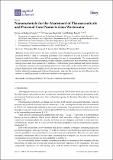Nanomaterials for the Abatement of Pharmaceuticals and Personal Care Products from Wastewater
Author(s)
Geobaldo, Francesco; Bonelli, Barbara; Freyria, Francesca S
Downloadapplsci-08-00170.pdf (1.729Mb)
PUBLISHER_CC
Publisher with Creative Commons License
Creative Commons Attribution
Terms of use
Metadata
Show full item recordAbstract
In this short-review, the most common types of both pharmaceutical and personal care products (PPCP, a class of “emerging pollutants”) are considered, as well as some of the most frequent methods for their removal that envisage the use of nanomaterials. The nanomaterials used in conservative methods (namely, reverse osmosis, nanofiltration and adsorption) are basically nanoporous solids. Non-conservative methods, which include photocatalysis and Fenton reaction, are currently considered more promising than conservative ones, as the former allow the (at least) partial degradation of the original molecules into more biodegradable by-products, which can be further abated by subsequent biological treatments, whereas the former are not efficient for the removal of small quantities of pollutants and have to be regenerated. Keywords: emerging pollutants; PPCPs; photocatalysis; nanomaterials
Date issued
2018-01Department
Massachusetts Institute of Technology. Department of ChemistryJournal
Applied Sciences
Publisher
Multidisciplinary Digital Publishing Institute
Citation
Freyria, Francesca, et al. “Nanomaterials for the Abatement of Pharmaceuticals and Personal Care Products from Wastewater.” Applied Sciences, vol. 8, no. 2, Jan. 2018, p. 170.
Version: Final published version
ISSN
2076-3417